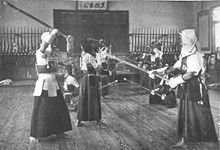Your Cart is Empty


Japan has a long and rich history with swordsmanship. The island nation first began making swords during the Kofun period (250 to 538). However, it wasn't until the Heian period (794 to 1185) when Japanese swords began to feature their characteristic hallmarks like curved blades and high-carbon steel. Today, we're going to explore some fun and interesting facts about Japanese swordsmanship.
#1) Most Japanese Swords are Designed for Two-Handed Use
While there are a few exceptions, most traditional Japanese swords, including the katana, are designed for two-handed use. Using these two-handed swords, samurai warriors would push down using their front hand and pull up with their back hand to perform deadly vertical cuts.
#2) Sword Drawing Was Emphasized
The katana paved the way for a new style of Japanese swordsmanship based around drawing the sword in a fast and fluid manner. Because the katana was worn with the cutting edge facing up, samurai warriors could draw it more quickly than other swords worn with the cutting edge facing down. This ultimately led to the creation of iaido, iaijutsi and battodo, all of which are still practiced today.
#3) Kendo Originated Out of Prohibition of Japanese Swords
The Japanese government eventually prohibited the act of carrying swords in public. To keep the art of swordsmanship, alive, however, some practitioners came together to create kendo. Meaning "way of the sword," kendo remains one of the world's most popular forms of sword-based martial arts.
#4) There Were 500+ Kenjutsu Schools During the Edo Period
According to various reports, there were more than 500 different kenjutsu schools in Japan during the country's Edo period. The popularity of kenjutsu during this time grew immensely, due largely in part to the transition from real swords to practice swords. With bamboo practice swords, practitioners could spar while significantly minimizing the risk of injury.
#5) Kenjutsu is Practiced Throughout the World
While kenjutsu -- the umbrella term for all schools of Japanese swordsmanship -- originated in feudal Japan, it's not practiced in countries throughout the world. In the United Stated, for instance, there are several kenjutsu schools.
#6) Kendo Focuses on the Katana
According to the All Japan Kendo Federation (AJKF), the concept of kendo is "a way to discipline the human character through the application of the principles of the katana." Therefore, it's safe to say that Japanese swordsmanship emphasizes the use of the katana.